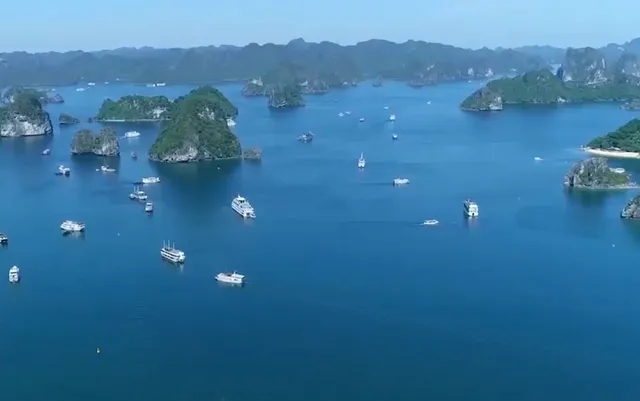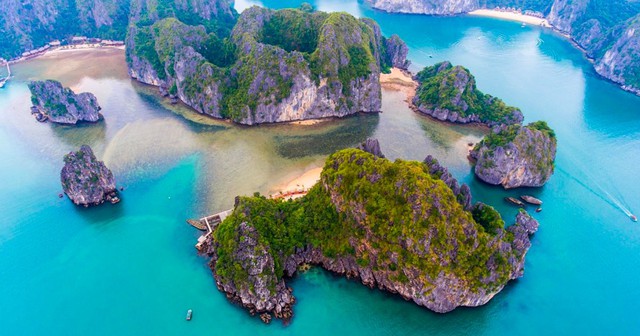Ha Long Bay - Cat Ba Archipelago recognized as World Geological Heritage
VGP - Ha Long Bay - Cat Ba Archipelago in the northern province of Quang Ninh and neighboring Hai Phong City was recognized as a world geological heritage site thanks to the outstanding global values of geological history and karst geomorphology on August 25.

Illustration photo
The Viet Nam-based Geological Heritage is one of 100 newly ones which were announced by the International Union of Geological Sciences (IUGS).
The IUGS planned to announce the above llist at the 37th International Geological Congress 2024 in Busan, South Korea, from August 25 to 31.
Ha Long Bay was recognized by UNESCO as a world heritage site twice in 1994 and 2000.
Cat Ba Archipelago is the largest limestone archipelago of the country. It has more than 360 islands, including Cat Ba Island to the south of Ha Long Bay.
The archipelago was recognized by UNESCO as a world biosphere reserve.
On September 16, 2023, at the 45th Session of the World Natural Heritage Committee, the UNESCO recognized Ha Long Bay - Cat Ba Archipelago as the first Vietnamese inter-provincial site as a world natural heritage site.
Unique patterns
Ha Long Bay - Cat Ba Archipelago includes all stages of the marine submergence of tropical karst as well as three main types of caves (old phreatic caves formed below the water table of the time; old karstic foot caves formed by lateral undercutting of cliffs at base level; and marine notch caves formed at sea level where rock structures are powerfully eroded and eventually reduced to a wave cut platform).

Sung Sot (Surprise) Cave, Ha Long Bay (Photo: Collection)
Ha Long Bay represents later stages of marine subduction, while the Cat Ba Archipelago adds important geological values to the heritage through its patterns of terrestrial and intertidal stages, some of which are rare, even unique.
In terms of geological and geomorphological value, Ha Long Bay is an excellent example of mature karst in humid tropical conditions with a complete karst evolution process spanning 20 million years thanks to the simultaneous combination of factors such as thick limestone layers, hot and humid climate and slow tectonic uplift.
Ha Long Bay has all the basic forms of karst terrain such as karst plains, funnels and valleys, karst peaks and towers, especially the Fengcong and Fengling karst terrains, which are typical of the final development stage of the tropical karst process.
The geological and geomorphological value of Ha Long Bay is also demonstrated through its rich cave system, formed 2,000,000 - 11,000 years ago. The process of sea flooding and sea erosion has made the karst geomorphology of Ha Long Bay unique in the world, fundamental to geomorphology science and of global significance. The Heritage Area has 775 islands, mostly limestone islands, with 66 caves, 42 marshes, 81 lakes inside the limestone islands and 193 sandbanks discovered along with a rich fossil system.

The exquisite natural beauty of Cat Ba
Meanhile, Cat Ba has diverse geology, expressed in the diversity of geological features (rocks, minerals, fossils, stratigraphy, structure, sedimentary environment...) and topography - geomorphology. Cat Ba Archipelago is the western edge of the Ha Long karst field that has been eroded by seawater. This is a special form of karst, one of the reasons that makes Ha Long Bay and the neighbouring limestone islands so attractive.
With the intersection of mountains, forests, sea and islands, Ha Long Bay - Cat Ba Archipelago is a typical area with high diversity in Asia, possessing 7 adjacent, successively developing tropical and subtropical marine - island ecosystems including: primary tropical rainforest ecosystem; cave ecosystem; mangrove forest ecosystem; intertidal ecosystem; coral reef ecosystem; soft bottom ecosystem; saltwater lake ecosystem. These ecosystems represent ecological and biological processes that are still evolving and developing, as demonstrated by the diversity of plant and animal communities.

